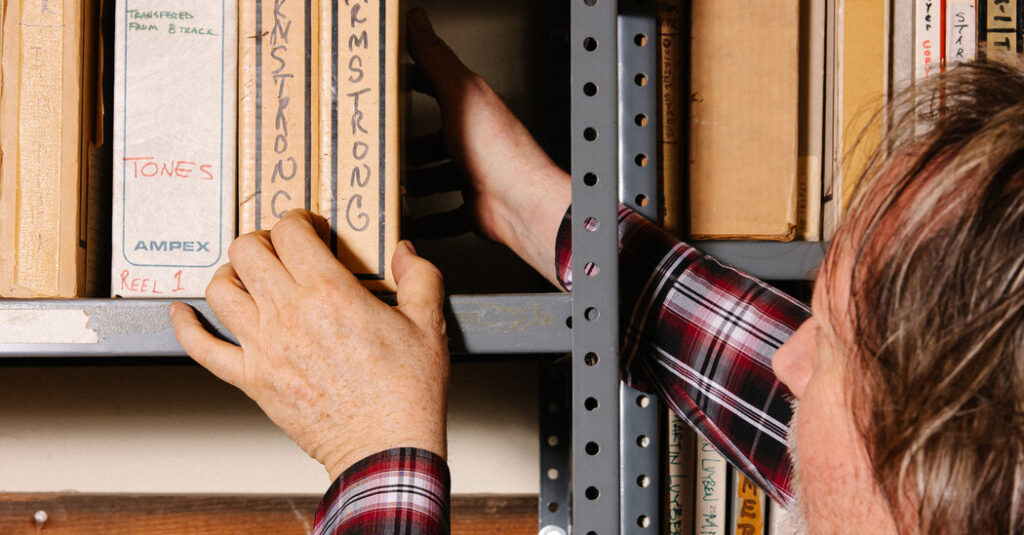Lost Tapes From Major Musicians Are Out There. These Guys Find Them.

In late 2020, Brian Kehew was working at the venerable Hollywood studio Sunset Sound when the owner asked him to help identify some tapes the Who had left behind. It was not an unusual request for Kehew, who has done tape transfers and mixes on hundreds of archival recording projects over the last 30 years, and serves as a tech and sometime backing musician for the band. He expected to find some overdubs or a safety copy of a master, nothing particularly important.
When he got his hands on the reels, he was shocked: The studio was sitting on all the original two-inch multitracks of the group’s 1975 album, “The Who by Numbers,” as well as previously unreleased songs from those sessions.
“I immediately contacted Pete Townshend, and we arranged to send the tapes back to England,” Kehew, a blond-haired Southern California native, said in a recent interview at his North Hollywood studio, which was lined with rare, vintage and obsolete tape machines. “The band had been looking for the tapes for years, but this was one place they hadn’t thought to check.”
For Kehew, a producer of Fiona Apple’s “Extraordinary Machine” and an expert on both the Beatles and Moog synthesizers, the recovery of the Who recordings underscored the fact that significant tapes “might be sitting in someone’s attic or barn or basement” and not where they belong, in a record company vault or an artist’s archive. “The obstacle to getting these tapes back in the right hands has always been the time and effort involved,” he said. “But what if there was a facile way to connect everyone that doesn’t involve a lot of hassle or red tape?”
The answer may be Master Tape Rescue, a company recently started by Kehew and his partner, Danny White, a fellow music industry veteran. The company acts as an archival matchmaking service of sorts, cataloging recordings from studios or private collections and then vetting and connecting rights holders with tape holders.
Over the past six months, as Kehew, 59, and White, 57, have canvassed the vaults of various studios and other holdings, they have discovered a wealth of fascinating material: previously unreleased Jimi Hendrix jam sessions, unknown Billie Holiday tapes, a trove of historic Chicago blues material, a large collection of professional concert recordings from artists including David Bowie, R.E.M. and Iggy Pop. “And it feels like that’s just the tip of the iceberg,” White said.
It was another historic discovery that brought White — a lanky, Indiana-born musician, studio owner and president of Sound Techniques, a recording console maker — into the project. In the late 2000s, he backed the Buddy Holly guitarist Tommy Allsup on tour. In 2009, inspired by the experience, he wrote a young adult novel, “The Last Rock and Roll Show,” about a pair of kids who discover lost Holly recordings. Life would imitate art when White was hired by the estate of a former Holly producer to assess its tape archive — and discovered more than 20 first-generation masters by the “Peggy Sue” singer.
Holly’s catalog was among the recordings reported to have been destroyed in the 2008 Universal Studios fire, which came to wide public knowledge in 2019. The find was major, showing that not everything was lost in the blaze. “It’s not all of Buddy’s masters,” White said, “but it’s a big chunk of his catalog, which is significant given the circumstances. And this was all sitting in a closet for years.”
In cases like the Who or Holly, there is real financial value in the recovered tapes. But most lost recordings, even ones from name acts, may be worth only a few hundred or thousand dollars. “Even though you have a tape, you don’t own the rights to what’s on it, so you can’t expect the moon,” Kehew said. “Labels might pay a small licensing fee use to a tape or track for a boxed set, sometimes they’ll buy it outright. Usually, they offer a finder’s fee or a storage fee — like, here’s a reward for preserving our tape all this time. It scales up and down with the artist, and how special the material is.”
But White said money isn’t the point: “We’re doing this more out of a sense of history, and hopefully help find some cool stuff that’s just been collecting dust for decades.”
NEARLY EVERY STUDIO that operated in the peak era of analog recording from the 1950s to the early 2000s has a locker, vault or room dedicated to housing tapes left behind by artists and labels.
Historically, finished album masters — held on a single quarter-inch tape reel, from which commercial copies would be manufactured — were considered the most valued asset. The multitracks — heavy, cumbersome two-inch reels of tape, containing the individual elements of the recording — would typically be collected and delivered to the label after a session. But inevitably a small percentage of tapes landed in the studio’s on-site storage, often forgotten completely by the artist and record company.
Paul Camarata, who owns Sunset Sound, watched his entire second-story space fill floor to ceiling with tapes like this, more than 1,500 at last count, from the big-band leader Harry James to the 1980s hitmakers Toto, before calling in Master Tape Rescue. “I’m always thinking we gotta get these tapes out of here,” he said. “But we’re in a strange quandary — we don’t own the tapes, and I would never just throw them away. We’ve just become an unwitting storage service.”
Over the years, record companies have “come down and scoured our archives hoping to find some gold,” he said. “But it’s kind of like leaving your car at the mechanic for 40 years and just expecting to pick it up one day.”
In 2010, Clay Blair began operating the Boulevard Recording Studio in Hollywood. It came with an illustrious history: Opened as Continental Recorders in 1966, it morphed into Producer’s Workshop in the 1970s (turning out projects by Pink Floyd, Fleetwood Mac and Steely Dan) and eventually became Westbeach Recorders, the pop-punk stronghold whose clients included Blink-182, Rancid and the Offspring. When Blair took over the space, he inherited a disused echo chamber that had been turned into a tape storage.
“There’s at least a couple hundred tapes in there that go all the way back to the ’60s,” said Blair, who is also working with Master Tape Rescue. “There are recordings by Liberace and Engelbert Humperdinck, a score for an Evel Knievel film, we found a Jerry Garcia tape from the ’70s, a soundtrack he did that’s never been released. Just the other day, we found the two-inch reels from Concrete Blonde’s hit ‘Joey.’ There’s all kinds of stuff hiding in these studios that nobody has any idea about.”
Still, numerous recording facilities that have been sold or closed over the years simply threw out their archives. The most famous example is Olympic Studios in London, which in 1987 took its entire tape inventory — including incredibly valuable multitrack recordings by bands like the Rolling Stones and Led Zeppelin — and placed them in a dumpster. Enterprising collectors salvaged as many reels as possible; some were reunited with the artists, others turned up as bootlegs.
Historically, multitrack recordings were seen as less valuable than finished master tapes. Back in the 1960s, bands would often roll back over recorded performances for fresh takes, or labels would bulk erase reels after a session and reuse the tape for other projects. “A lot of great, interesting recordings got lost that way,” said Andrew Sandoval, a reissue producer who has specialized in catalog work for ’60s groups like the Monkees and the Beach Boys.
Sandoval said that even major artists of the era, like the Kinks, have very few of their early multis. “You’re never going to hear alternate takes of classics like ‘You Really Got Me’ or ‘All of the Day,’” he said. “None of those things exist.”
During the 1970s and ’80s, multitracks were haphazardly stored, organized and prized, even by major labels. It wasn’t uncommon to walk into a place like Coast Recording Equipment Supply, a pro audio shop in Hollywood, and find used reels being sold for recording that contained multitrack masters by bands like the Doors.
It wasn’t until the CD era and the explosion of deep-dive compilations and boxed sets in the late ’80s and early ’90s that record companies started to fully realize the value of their multitracks. “When you get into the re-marketing of music and creating reissues, the first thing a label asks is: ‘Is there something new here?’” Sandoval said. “In order to find or create something new, you usually need to go back to the multitracks — that’s your biggest source of alternate takes, outtakes and unreleased material.”
Today, multitracks arguably hold even more value thanks to the rise of remix projects, the development of immersive audio formats like Dolby Atmos, and even TV, film and commercial sync opportunities, which often require use of the original recording elements.
“The ability to recast an artist’s music, to present it in a new way, usually depends on the multitracks,” said John Jackson, the longtime Sony/Legacy A&R executive. Now running his own consultancy, advising Billy Joel, Rosanne Cash and the estate of AC/DC’s Bon Scott, he noted that “if you don’t have the multitracks or have a plan for the multitracks, you’re not recognizing and celebrating the value of that artist’s music fully.”
THERE’S NO QUESTION that the vagaries of the music business have claimed plenty of important recordings over the years.
In February, the 146-track boxed set “Written in Their Soul: The Stax Songwriter Demos” won best historical album at the Grammys. Chronicling the tunesmiths behind the iconic Memphis soul label, it was a 20-year passion project for its producer, Cheryl Pawelski. A former catalog executive at Capitol and Warner Music who now runs her own label, Omnivore, Pawelski said the original tapes that make up the Stax box had actually been thrown out years earlier.
“Fortunately, before they got rid of the tapes sometime in the ’90s, the publisher that owned the material transferred it all to DAT,” said Pawelski, referring to the now outdated digital tape format. “That’s because a single DAT could hold 90 or 120 minutes — it was a space saving measure.”
Pawelski knows that “Written in Their Soul” is a feel-good story in a business often filled with dispiriting tales of lost history. “God knows what’s been thrown out. Just thinking about the stuff that probably wound up in landfills in Memphis or Chicago, it makes me very sad,” she said. “As music lovers, as reissue producers, we’re chasing something that’s very ephemeral in what is essentially a business environment. And I think a lot of music has gotten the raw end of those business dealings.”
Corporate neglect and studio closures aren’t the only reasons tapes get lost or go missing; there have been more nefarious forces at work as well. Jackson, who spent years overseeing Sony/Legacy’s work on the Elvis Presley catalog, noted that even the biggest artists have not been immune from having their recordings stolen.
The Presley archivist Ernst Jorgensen spent “decades putting Elvis’s whole tape collection back together,” Jackson said. “And a lot of times that involved someone saying, ‘Meet me at this motel behind Graceland and I’ll sell you the multitracks of this session.’”
A few years ago, Kehew worked on a reissue of a 20-times-platinum LP by a big major-label act from the 1990s. He noticed the multitracks were not in the label’s vault, but since those tapes weren’t needed for the project, he thought little of it. A few months later, he was approached by someone who had inherited a store of tapes and wanted him to assess the contents. There, among the mostly worthless reels, were “the multitracks for this 20-million-selling album,” Kehew said, “just sitting in a dusty garage in downtown L.A., next to some boots and a bunch of oil cans.”
Someone had checked out the tapes from the label without a signature, he said, later abandoning them. “The label was very happy to have them back. The band probably never even knew they were missing.”
Sandoval believes the untapped holdings of studios and private collections could produce a bounty in the coming years. “There’s recordings people have been sitting on for one reason or another,” he said. “As those folks pass away, and their families find and inherit the tapes, that stuff is finally going to surface.”
Kehew and White are counting on that and hope to streamline the process through their efforts with Master Tape Rescue. “I do believe there are hundreds of studios all over the world that have tape vaults that are worth exploring,” Kehew said. “Or that there are producers or engineers, or estates, who might have material of real value for artists or labels. A lot of stuff is still out there — it’s just a matter of finding it.”
Audio produced by Parin Behrooz.





